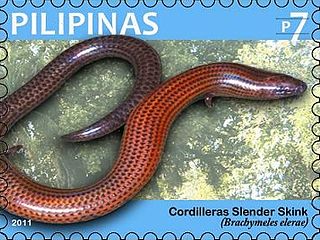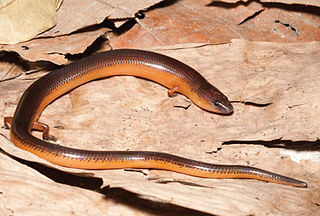
Brachymeles is a genus of skinks. The majority of the species within the genus are endemic to certain island ecosystems in the Philippines. In 2018, the Zoological Society of London through its EDGE of Existence Program listed the Cebu small worm skink as the 80th most evolutionarily distinct and globally endangered reptile species in the world, making it the most endangered member of the genus Brachymeles.

Miriam's skink is a skink, a lizard in the family Scincidae. The species is endemic to Thailand.

Brachymeles bonitae, commonly known as the stub-limbed burrowing skink or pretty short-legged skink, is a species of skink found in the Philippines. It was first described in 1839 by André Marie Constant Duméril and Gabriel Bibron. It is endemic to the Philippines.

Brachymeles elerae, the common short-legged skink, is a species of skink endemic to the Philippines. It is found throughout most of the country, albeit very rarely, hence the species is poorly characterized.

Brachymeles bicolor, common name two-colored short-legged skink, is a species of skink endemic to Luzon, the Philippines. It is widely distributed through the island, at elevations of 250 to 850 m above sea level. However, its population is declining due to deforestation, and hence the species is classified as least concern by the IUCN.
Brachymeles tungaoi, Tungao's slender skink, is a species of skinks found in the Philippines, in the family Scincidae.
Brachymeles boholensis, the Bohol short-legged skink, is a species of skink endemic to the Philippines.
Brachymeles burksi, the Burks' burrowing skink, is a species of skink endemic to the Philippines. It occurs on the islands of Mindoro and Marinduque. It was synonymized with Brachymeles bonitae by Walter C. Brown in 1956 but revalidated by Cameron D. Siler and colleagues in 2020.
Brachymeles cebuensis, Rabor's short-legged skink, is a species of skink endemic to the Philippines.
Brachymeles gracilis, the graceful short-legged skink, is a species of skink endemic to the Philippines.
Brachymeles hilong, the graceful short-legged skink, is a species of skink endemic to the Philippines.
Brachymeles lukbani is a species of skink endemic to the Philippines. The skink species Brachymeles lukbani has a unique pattern of limb reduction; as an adult, it seems to be limbless on the outside but has a concealed limb rudiment, which is called cryptomelia. This phenomenon sheds light on the evolutionary processes responsible for the recurring reduction and loss of limbs in this species, suggesting the existence of temporary growing limbs during embryonic stages.
Brachymeles mindorensis, the Mindoro short-legged skink, is a species of skink endemic to the Philippines.
Brachymeles samad, the Eastern Visayas slender skink, is a species of skink endemic to the Philippines.

Brachymeles samarensis, Brown's short-legged skink, is a species of skink endemic to the Philippines.

Brachymeles schadenbergi, Schadenberg's burrowing skink, is a species of skink endemic to the Philippines.

Brachymeles talinis, Duméril's short-legged skink, is a species of skink endemic to the Philippines.
Brachymeles vermis, Taylor's short-legged skink, is a species of skink endemic to the Philippines.
Brachymeles vulcani, the Camiguin Sur slender skink, is a species of skink endemic to the Philippines.

Brachymeles wrighti, Wright's short-legged skink, is a species of skink endemic to the Philippines.










